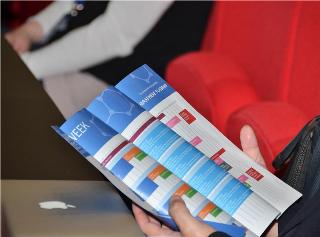Jun 24 2015
Scientists must focus on graphene and 2D technologies that hold the biggest promise in terms of industrial applications, conference delegates told.
 © 2015 Christine Twigg, The University of Manchester
© 2015 Christine Twigg, The University of Manchester
A “hunger to innovate and create” will be key to ensuring the success of Europe’s Graphene Flagship, delegates at Graphene Week 2015 have heard.
In his opening address to the 10th Graphene Week conference, Thomas Skordas, head of the flagship unit at the European Commission, from which the flagship draws half its funding, hailed the project as a pioneering approach to collaborative research in Europe that would help provide a competitive advantage to industry.
Europe is often accused of lacking ambition, noted Skordas, and with graphene, Europe is taking a risk: “Graphene holds the promise of becoming a key source of innovation. It could provide technology bricks that enable a wide range of products and applications in many industry sectors. The flagship has the potential to show how an inspiring goal can overcome fragmentation, and be an example of collaboration across borders.”
Skordas congratulated the flagship for its considerable achievements over the first 18 months. These include hundreds of high-quality scientific publications, and a growing number of industrial collaborations. All this is the result of exemplary management, he added. The flagship has become an international reference for graphene research and development, establishing Europe as a global leader in the field.
Challenges for the flagship include closely connecting science with industry, and the development of a long-term programme with innovation and technology transfer at its core. Skordas said that the flagship should focus its activities on those areas in which it can make a difference: “It must find and maintain the right balance between academia and industry – between longer-term scientific research, and applied research and innovation, bringing together the push from new technologies with the pull from industrial needs.”
Skordas noted the considerable amount of constructive critical attention on the flagship, including from Brussels, and said focus and integration – including integrating new industrial partners – are critical.
“There will be little gain in choosing application areas where only incremental progress is to be expected. You must focus on those technologies that hold the biggest promise in terms of industrial applications, because graphene has the potential to deliver disruptive innovations that create new applications and new products. This will also translate in terms of the consortium membership, which should over time narrow down to those partners most suited to contributing to those key innovations.”
Skordas concluded his presentation by urging those present to maintain their motivation and enthusiasm, together with a hunger to innovate and create, stating: “In the end this is what will make the difference.”
The centrepiece of the Graphene Flagship calendar, the 10th Graphene Week conference is taking place at the University of Manchester. Home to the UK’s National Graphene Institute, Manchester is also the research base of Andre Geim and Kostya Novoselov, the lauded scientists who in 2010 won the Nobel Prize in Physics for their pioneering work on the properties of graphene.
Flagship director Jari Kinaret described the 2015 conference as a homecoming. “For me personally, it is exciting to have Graphene Week in Manchester, as this is where it started,” he said. “Manchester is one of the leading centres for graphene research. I encourage you to make connections, and discuss opportunities and challenges.”
Vladimir Fal’ko, the University of Lancaster physicist and co-founder of Graphene Week, used his address to conference stress the importance of two-dimensional materials as a whole. Growth in the field of graphene and related materials has affected Manchester in many ways, noted Fal’ko, not least the National Graphene Institute, of which he is director. Graphene Week delegates were invited to view its recently opened and architecturally stunning building.